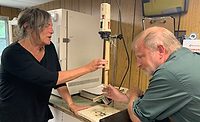Sustainable Building Options
Adhesives, membranes and sealants play an important role in the determination of building projects' sustainability levels.

 How does indoor air quality impact building occupants in a practical sense? A young student has problems breathing when he is in school. He experiences itchy eyes, a runny nose and a constant headache. When he is not in school, he does not have any of these symptoms. A young mother goes to work every day and comes home feeling lethargic; she gets plenty of rest, but she is always tired during the week or when she is at the office. When she travels, she cannot understand why she is less tired than usual-shouldn’t she be more tired while traveling? These types of situations are becoming more commonplace.
How does indoor air quality impact building occupants in a practical sense? A young student has problems breathing when he is in school. He experiences itchy eyes, a runny nose and a constant headache. When he is not in school, he does not have any of these symptoms. A young mother goes to work every day and comes home feeling lethargic; she gets plenty of rest, but she is always tired during the week or when she is at the office. When she travels, she cannot understand why she is less tired than usual-shouldn’t she be more tired while traveling? These types of situations are becoming more commonplace.
In many cases, symptoms like these point to sick building syndrome, which may be the result of the off-gassing of volatile organic compounds (VOCs) that may be present in building materials. These can include chemicals, odors from fibers, or fumes from building materials as they cure and dry. Many of the building materials used in today’s construction methods contain products that can cause the problems mentioned in these examples. The construction business and the materials and methods used to construct buildings seem limitless; for the purposes of this article, we will focus on the use of ceramic tile and stone, and the related adhesives, membranes, and sealants that are used to install these finish materials.

People are indoors approximately 70-90% of the time. With that in mind, good indoor air quality is very important. The design community has long recognized this fact and has inspired federal and state organizations to create programs that intend to target the issue of indoor air quality. Today, dozens of programs have established guidelines to address this issue. An increasing number of end users and design professionals are recognizing that a healthy building environment is an essential part of any community.
Along with the health issues of our buildings comes the sustainability and quality of building materials used. What does this actually mean? Simply put, sustainability can be defined as how long the products used in a structure will last before they have to be replaced or repaired. For example, how long will the ceramic tile finish last on a floor, as opposed to an installation of carpeting or resilient flooring? It’s important to note that health and sustainability issues go hand in hand since the frequency with which finishes are replaced impacts the buildings’ indoor air quality.

Adhesives, membranes and sealants play an important role in this regard, since they are often used in adhering or complementing many finishes. Therefore, when making the determination for whether a product is environmentally friendly or not, the following questions should be addressed:
The ingredients that go into ceramic tile are mainly clay and shale; these are pressed or extruded into shape and then fired at high temperatures to achieve a very dense and durable finish. Since tile is fired in kilns at extremely high temperatures, the finished product contains no VOCs that can be released into the air that we breathe.¹
In addition, porcelain tile manufacturers have become so effective in their production processes that the cost of porcelain tile is actually decreasing-as opposed to the cost of other types of flooring and wall finishes, which continues to increase. In the past, when a design professional was looking for an inexpensive alternative, they accepted the drawbacks of off-gassing and short lifecycles associated with these other types of finishes (e.g., vinyl composition tile, linoleum, carpet, rubber, paint, wall covering). They no longer have to compromise. Ceramic and porcelain tiles are high-performance products. Durable, dense and easy to maintain, porcelain tiles will not easily stain, since they generally feature absorption rates of less than 0.5%. Typical latex Portland cement-based adhesives, mortars, grouts, membranes and sealants are also high-performance, environmentally friendly products that come in well below the threshold limits established by Leadership in Energy and Environmental Design (LEED).
Ceramic tile and stone is also considered clean fill. If, for any reason, tile or stone is removed (and this is usually only because the style looks dated), it can be buried in a landfill and will not harm the ecology or the environment. Unlike the adhesive mortars that are used to install resilient and wood floors or carpeting, tile and stone adhesives are typically Portland cement-based and do not pose any danger to the environment. They are inert once they harden and do not off-gas or emit any VOCs. Mineral-based finish flooring products such as tile, masonry, terrazzo, and cut stone automatically qualify for LEED credit without any indoor air quality testing requirements, per LEED IEQ Credit 4.3, addendum 4/14/2010, p. 488.²

As indicated, the TVOC contained in a typical ceramic tile and stone installation is practically nonexistent. When compared to the other types of finishes, it is evident that ceramic tile and stone contribute to a healthier building environment. Manufacturers and promoters of the other finish types will tell us that off-gassing of the VOCs diminishes as time passes, and that is true to an extent. Many strides have been made to manufacture these types of finishes and adhesives with lower VOC content. Several of the larger building environment watchdog agencies have set stricter guidelines to ensure that this happens.4 However, these types of finishes are still significantly higher in VOC content when compared to ceramic tile and stone.
With all of the green building buzz flying around these days, it can be challenging to understand which products are actually green. Several factors can help design professionals, specifiers and building owners determine which product features are truly desirable and beneficial to building occupants:
For more information, contact Laticrete International, Inc. at One Laticrete Park North, Bethany, CT 06524; (203) 393-0010; fax (203) 393-1296; or visit www.laticrete.com.
2. LEED Reference Guide for Green Building Design and Constuction, 2009 Edition, Document Addenda, IEQc4.3, p. 29.
3. California Department of Health Services (2002), Reducing Occupant Exposure to Volatile Compounds from Office Building Construction Materials: Non-Binding Guidelines, May 17, 2005, www.cal-iaq.org/vocs/voc-publications.
4. South Coast Air Quality Management District (2001), May 17, 2005, www.aqmd.gov/prdas/Coatings/table_of_standards.htm.


The beauty of ceramic tile and stone installations also provides sustainable and environmentally friendly characteristics to construction projects.
In many cases, symptoms like these point to sick building syndrome, which may be the result of the off-gassing of volatile organic compounds (VOCs) that may be present in building materials. These can include chemicals, odors from fibers, or fumes from building materials as they cure and dry. Many of the building materials used in today’s construction methods contain products that can cause the problems mentioned in these examples. The construction business and the materials and methods used to construct buildings seem limitless; for the purposes of this article, we will focus on the use of ceramic tile and stone, and the related adhesives, membranes, and sealants that are used to install these finish materials.

Ceramic tile and stone flooring in a hotel atrium with plenty of foliage helps create an inviting and healthy building environment.
Background
The term “green,” when used in discussions that concern buildings and construction, signifies healthy and environmentally friendly products and buildings. But it is first important to understand the evolution of the green building movement. The respiratory and allergic reactions of building occupants can be traced back to reactions that result from some of the products that are in the structure.People are indoors approximately 70-90% of the time. With that in mind, good indoor air quality is very important. The design community has long recognized this fact and has inspired federal and state organizations to create programs that intend to target the issue of indoor air quality. Today, dozens of programs have established guidelines to address this issue. An increasing number of end users and design professionals are recognizing that a healthy building environment is an essential part of any community.
Along with the health issues of our buildings comes the sustainability and quality of building materials used. What does this actually mean? Simply put, sustainability can be defined as how long the products used in a structure will last before they have to be replaced or repaired. For example, how long will the ceramic tile finish last on a floor, as opposed to an installation of carpeting or resilient flooring? It’s important to note that health and sustainability issues go hand in hand since the frequency with which finishes are replaced impacts the buildings’ indoor air quality.

Environmentally Friendly Products
In today’s construction marketplace, the phrase “environmentally friendly product” is liberally used to describe an array of items. In truth, environmentally friendly products are those that do not harm the space that humans occupy and do not have any adverse impact on the ecology or environment during their harvesting, manufacturing, installation, curing/drying, and duration of use.Adhesives, membranes and sealants play an important role in this regard, since they are often used in adhering or complementing many finishes. Therefore, when making the determination for whether a product is environmentally friendly or not, the following questions should be addressed:
- How are the finishes and adhesive materials manufactured?
- Does the material degrade or break down over time?
- Does the material require frequent maintenance or need to be replaced in a relatively short period of time?
- How long will it off-gas (emit harmful VOCs)?
The ingredients that go into ceramic tile are mainly clay and shale; these are pressed or extruded into shape and then fired at high temperatures to achieve a very dense and durable finish. Since tile is fired in kilns at extremely high temperatures, the finished product contains no VOCs that can be released into the air that we breathe.¹
In addition, porcelain tile manufacturers have become so effective in their production processes that the cost of porcelain tile is actually decreasing-as opposed to the cost of other types of flooring and wall finishes, which continues to increase. In the past, when a design professional was looking for an inexpensive alternative, they accepted the drawbacks of off-gassing and short lifecycles associated with these other types of finishes (e.g., vinyl composition tile, linoleum, carpet, rubber, paint, wall covering). They no longer have to compromise. Ceramic and porcelain tiles are high-performance products. Durable, dense and easy to maintain, porcelain tiles will not easily stain, since they generally feature absorption rates of less than 0.5%. Typical latex Portland cement-based adhesives, mortars, grouts, membranes and sealants are also high-performance, environmentally friendly products that come in well below the threshold limits established by Leadership in Energy and Environmental Design (LEED).
Ceramic tile and stone is also considered clean fill. If, for any reason, tile or stone is removed (and this is usually only because the style looks dated), it can be buried in a landfill and will not harm the ecology or the environment. Unlike the adhesive mortars that are used to install resilient and wood floors or carpeting, tile and stone adhesives are typically Portland cement-based and do not pose any danger to the environment. They are inert once they harden and do not off-gas or emit any VOCs. Mineral-based finish flooring products such as tile, masonry, terrazzo, and cut stone automatically qualify for LEED credit without any indoor air quality testing requirements, per LEED IEQ Credit 4.3, addendum 4/14/2010, p. 488.²

Direct Comparisons
When a comparison is made of the VOCs contained in floor and wall finishing products, it is obvious to see why ceramic tile and stone is the better finish choice. Table 1 compares the types of finishes and their VOC content.³ The adhesives used for the application of the materials can also contribute to the total volatile organic compounds (TVOCs) in a building environment. Table 2 lists the typical TVOCs for the adhesives used in some of these finishes.³As indicated, the TVOC contained in a typical ceramic tile and stone installation is practically nonexistent. When compared to the other types of finishes, it is evident that ceramic tile and stone contribute to a healthier building environment. Manufacturers and promoters of the other finish types will tell us that off-gassing of the VOCs diminishes as time passes, and that is true to an extent. Many strides have been made to manufacture these types of finishes and adhesives with lower VOC content. Several of the larger building environment watchdog agencies have set stricter guidelines to ensure that this happens.4 However, these types of finishes are still significantly higher in VOC content when compared to ceramic tile and stone.
With all of the green building buzz flying around these days, it can be challenging to understand which products are actually green. Several factors can help design professionals, specifiers and building owners determine which product features are truly desirable and beneficial to building occupants:
- Long product lifecycle
- No negative contribution to indoor air quality (low VOC-emitting materials)
- Green-conscious manufacturing
- Hypoallergenic products
- Low maintenance
- Recycled material contribution
- Regionally supplied products
For more information, contact Laticrete International, Inc. at One Laticrete Park North, Bethany, CT 06524; (203) 393-0010; fax (203) 393-1296; or visit www.laticrete.com.
References
1. Tile Council of North America, Tile is the Natural Choice, 2009, www.tileusa.com.2. LEED Reference Guide for Green Building Design and Constuction, 2009 Edition, Document Addenda, IEQc4.3, p. 29.
3. California Department of Health Services (2002), Reducing Occupant Exposure to Volatile Compounds from Office Building Construction Materials: Non-Binding Guidelines, May 17, 2005, www.cal-iaq.org/vocs/voc-publications.
4. South Coast Air Quality Management District (2001), May 17, 2005, www.aqmd.gov/prdas/Coatings/table_of_standards.htm.
SIDEBAR: About VOCs
Volatile organic compounds (VOCs) are ingredients contained in building materials that may escape as they air dry or cure. As building materials cure or dry, an odor may be emitted and cause a person to develop reactions or sensitivities to the materials in a building. Everyone recognizes that new car or new carpet smell; VOCs are part of that scent. It is the off-gassing of the VOCs that creates these respiratory or allergic reactions. Some of the ingredients in building materials that off-gas are formaldehyde, ozone, particles and volatile organic compounds. Ceramic tile and stone, however, offer many benefits in the area of VOC emissions.Links
Looking for a reprint of this article?
From high-res PDFs to custom plaques, order your copy today!






